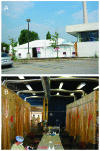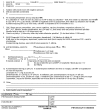Hospital preparedness and SARS
- PMID: 15200807
- PMCID: PMC3323236
- DOI: 10.3201/eid1005.030717
Hospital preparedness and SARS
Abstract
On May 23, 2003, Toronto experienced the second phase of a severe acute respiratory syndrome (SARS) outbreak. Ninety cases were confirmed, and >620 potential cases were managed. More than 9,000 persons had contact with confirmed or potential case-patients; many required quarantine. The main hospital involved during the second outbreak was North York General Hospital. We review this hospital's response to, and management of, this outbreak, including such factors as building preparation and engineering, personnel, departmental workload, policies and documentation, infection control, personal protective equipment, training and education, public health, management and administration, follow-up of SARS patients, and psychological and psychosocial management and research. We also make recommendations for other institutions to prepare for future outbreaks, regardless of their origin.
Figures


Similar articles
-
Is New Jersey ready for a resurgence of SARS?N J Med. 2004 Sep;101(9 Suppl):53-6; quiz 57-8. N J Med. 2004. PMID: 15497735 Review. No abstract available.
-
Public health measures to control the spread of the severe acute respiratory syndrome during the outbreak in Toronto.N Engl J Med. 2004 Jun 3;350(23):2352-61. doi: 10.1056/NEJMoa032111. N Engl J Med. 2004. PMID: 15175437
-
Breakthrough of the year. SARS: a pandemic prevented.Science. 2003 Dec 19;302(5653):2045. doi: 10.1126/science.302.5653.2045. Science. 2003. PMID: 14684791 No abstract available.
-
The threat of severe acute respiratory syndrome (SARS).West Indian Med J. 2003 Jun;52(2):91-4. West Indian Med J. 2003. PMID: 12974057 Review.
-
SARS control and psychological effects of quarantine, Toronto, Canada.Emerg Infect Dis. 2004 Jul;10(7):1206-12. doi: 10.3201/eid1007.030703. Emerg Infect Dis. 2004. PMID: 15324539 Free PMC article.
Cited by
-
[Lessons from SARS].Presse Med. 2007 Feb;36(2 Pt 2):299-302. doi: 10.1016/j.lpm.2006.12.005. Epub 2007 Jan 2. Presse Med. 2007. PMID: 17258678 Free PMC article. Review. French.
-
COVID-19: lessons learned from a paediatric high consequence infectious diseases unit.Arch Dis Child. 2021 Apr;106(4):e20. doi: 10.1136/archdischild-2020-319114. Epub 2020 Jun 9. Arch Dis Child. 2021. PMID: 32518138 Free PMC article. Review. No abstract available.
-
Ethical dilemmas due to the Covid-19 pandemic.Ann Intensive Care. 2020 Jun 17;10(1):84. doi: 10.1186/s13613-020-00702-7. Ann Intensive Care. 2020. PMID: 32556826 Free PMC article. Review.
-
[Emergency room management of contaminated patients].Unfallchirurg. 2008 Jun;111(6):459-63. doi: 10.1007/s00113-007-1358-8. Unfallchirurg. 2008. PMID: 18066517 German.
-
Controlling SARS: a review on China's response compared with other SARS-affected countries.Trop Med Int Health. 2009 Nov;14 Suppl 1(Suppl 1):36-45. doi: 10.1111/j.1365-3156.2008.02146.x. Epub 2009 Jun 5. Trop Med Int Health. 2009. PMID: 19508440 Free PMC article. Review.
References
-
- Toronto Public Health. Case definition of severe acute respiratory syndrome (SARS). [Accessed August 30, 2003]. Available at: http://www.city.toronto.on.ca/health/sars
-
- Centers for Disease Control and Prevention. Update: severe acute respiratory syndrome—Toronto, Canada, 2003. MMWR Morb Mortal Wkly Rep. 2003;52:547–50. - PubMed
-
- World Health Organization. Case definition of severe acute respiratory syndrome (SARS). [Accessed August 30, 2003]. Available at: http://www.who.int/csr/sars/country/2003_07_02/en
Publication types
MeSH terms
LinkOut - more resources
Full Text Sources
Miscellaneous
